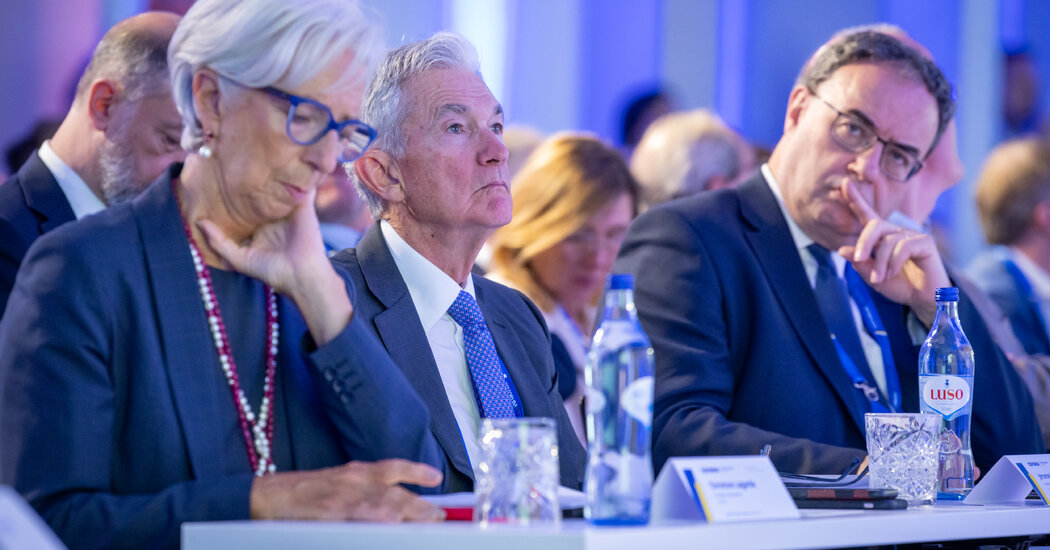Jerome H. Powell, the chair of the Federal Reserve, said that inflation was once again coming down in the United States and that the Fed had “made quite a bit of progress” in cooling price increases back toward its goal.
Inflation “now shows signs of resuming its disinflationary trend,” Mr. Powell said on Tuesday at the European Central Bank’s annual conference in Sintra, Portugal. It was an optimistic message after the Fed’s fight against inflation hit a speed bump earlier this year.
Fed officials have been waiting to see further progress on inflation before they begin to lower interest rates, which are currently set to their highest level in decades, at 5.3 percent. Mr. Powell declined to say exactly when officials could begin to cut borrowing costs, but suggested that they could lower rates if inflation data continued on its current track or if the labor market weakened.
“What we’d like to see is more data like what we’ve been seeing recently,” Mr. Powell said, later adding, “We have the ability to take our time and get this right.”
Sitting next to Mr. Powell on the panel in Sintra, Christine Lagarde, the president of the European Central Bank, said that European policymakers also weren’t in a rush to lower rates again, after an initial cut in June. E.C.B. officials would continuously reassess whether economic data gave them enough confidence to cut interest rates further, she added.
Inflation is “heading in the right direction,” she said. “But we still believe that it’s likely to be a bumpy road until the end of 2024.”
As inflation has slowed in both the United States and Europe over the past year and a half, central bankers have been trying to calibrate how much effort they need to put into stamping out price pressures to return inflation to their 2 percent targets. The Fed’s preferred inflation measure came in at 2.6 percent in May. In the eurozone, the annual inflation rate slowed to 2.5 percent in June, data published on Tuesday showed.
The Fed has left interest rates unchanged since July 2023. Officials initially expected to cut interest rates several times this year, but they have instead held borrowing costs steady so far as they await evidence that inflation will continue to come down. At their June meeting, most Fed officials projected one or two rate cuts before the end of the year, and investors now expect that those rate cuts could start in September.
When asked if a rate cut could come then, Mr. Powell said he wasn’t going to be “landing on any specific date today,” but he also noted that there were risks to both moving too early and moving too late. Going too early could allow inflation to remain higher. Going too late could squeeze the economy too much and risk a recession.
“We have two-sided risks now more so than we did a year ago,” Mr. Powell said. “That’s a big change.”
Mr. Powell noted that some of the lingering inflation in services in the United States was the delayed result of earlier trends, like a run-up in market-based rent costs that had only slowly fed into official data. He recognized that Fed officials did not expect to lower inflation fully back to their 2 percent goal this year.
“The main thing is, we’re making real progress,” he said.
While inflation in the United States and Europe has followed a relatively similar trajectory for the past three years, their economies have diverged significantly. The United States has grown surprisingly strongly, but the eurozone is only just emerging from five quarters of economic stagnation.
The E.C.B. cut interest rates last month for the first time since 2019, as policymakers forecast inflation would return to 2 percent late next year. But European officials have resisted indicating how many more rate cuts could come, as they are wary of stubbornly high inflation in the services sector. Last month, services inflation in the eurozone held at 4.1 percent.
“Services is the difficult one,” Ms. Lagarde said. Policymakers are trying to understand whether services inflation has been caused by permanent changes in the sector or by prices catching up to other areas that have seen rising inflation, such as energy.
The E.C.B. is not expected to cut rates at its next meeting in July, but some investors are betting that rates could be lowered in September, when the central bank also publishes new economic forecasts. Traders are betting on one or two more rate cuts this year.
Mr. Powell and Ms. Lagarde spoke in front of current and former policymakers from around the world, as well as academic and bank economists, gathered to discuss “monetary policy in an era of transformation” and the challenges facing central bankers.
Earlier on Tuesday, attendees debated whether the recent surge in inflation in the United States and Europe was caused by supply shocks, like shipping disruptions during the coronavirus pandemic and Russia’s invasion of Ukraine, or an increase in demand from expansionary fiscal policies and pent-up demand after lockdowns. They also worried about how geopolitical risks, including wars and trade tariffs, tended to lead to higher inflation.



